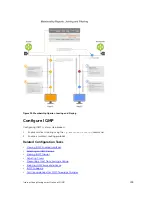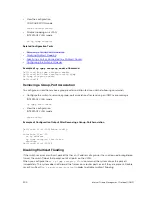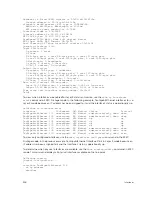
Protocol
Behavior when EIS is Enabled
Behavior when EIS is Disabled
dns
EIS Behavior
Default Behavior
ftp
EIS Behavior
Default Behavior
ntp
EIS Behavior
Default Behavior
radius
EIS Behavior
Default Behavior
Sflow-collector
Default Behavior
Snmp (SNMP Mib response and
SNMP Traps)
EIS Behavior
Default Behavior
ssh
EIS Behavior
Default Behavior
syslog
EIS Behavior
Default Behavior
tacacs
EIS Behavior
Default Behavior
telnet
EIS Behavior
Default Behavior
tftp
EIS Behavior
Default Behavior
icmp (ping and traceroute)
EIS Behavior for ICMP
Default Behavior
Behavior of Various Applications for Switch-Destined Traffic
This section describes the different system behaviors that occur when traffic is terminated on the switch.
Traffic has not originated from the switch and is not transiting the switch. Switch-destined traffic is
applicable only for applications which act as server for the TCP session and also for ICMP-based
applications like ping and traceroute. FTP, SSH, and Telnet are the applications that can function as
servers for the TCP session.
EIS Behavior:
If source TCP or UDP port matches an EIS management or a non-EIS management
application and source IP address is management port IP address, management port is the preferred
egress port selected based on route lookup in EIS table. If the management port is down or the route
lookup fails, packets are dropped.
If the source TCP/UDP port or source IP address does not match the management port IP address, a
route lookup is done in the default routing table.
EIS behavior for ICMP:
ICMP packets do not have TCP/UDP ports. In this case, to perform an EIS route
lookup for ICMP-based applications (ping and traceroute), you must configure ICMP as a management
application. If the management port is down or the route lookup fails, packets are dropped.
If source IP address does not match the management port IP address route lookup is done in the default
routing table.
Internet Group Management Protocol (IGMP)
313
Summary of Contents for Z9000
Page 1: ...Dell Configuration Guide for the Z9000 System 9 7 0 0 ...
Page 80: ...grub reboot 80 Management ...
Page 128: ... 0 Te 1 1 Te 1 2 rx Flow N A N A 128 Access Control Lists ACLs ...
Page 491: ...Figure 70 Configuring OSPF and BGP for MSDP Multicast Source Discovery Protocol MSDP 491 ...
Page 496: ...Figure 73 MSDP Default Peer Scenario 1 496 Multicast Source Discovery Protocol MSDP ...
Page 497: ...Figure 74 MSDP Default Peer Scenario 2 Multicast Source Discovery Protocol MSDP 497 ...
Page 498: ...Figure 75 MSDP Default Peer Scenario 3 498 Multicast Source Discovery Protocol MSDP ...
Page 760: ...Figure 100 Single and Double Tag TPID Match 760 Service Provider Bridging ...
Page 761: ...Figure 101 Single and Double Tag First byte TPID Match Service Provider Bridging 761 ...
















































